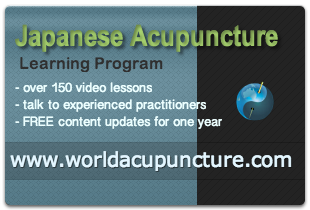We are continuing to revamp the Japanese Acupuncture content at http://www.worldacupuncture.com and are planning some major design upgrades to help make it even easier for our members to utilize.
Many of these changes should be in effect by the end of the year and the World Acupuncture team welcomes any feedback from you.
We are well into spring down under and the weather has been magical, plenty of rain, plenty of sunshine and blue skies.
The yin and the yang are in harmony with the occasional spectacular evening storm to entertain us.
Our economy is definitely feeling the flow on effects of the GFC and the effects are being felt in many clinics.
We can counteract this malady by continuing to refine our and develop our skills and studying hard, letting positive clinical outcomes do the walking and talking for us.
As a member , past member or potential member of http://worldacupuncture.com please feel free to use any of the videos on our You Tube channel to help educate your patients and potential patients regarding the efficacy of Traditional Japanese Acupuncture/Meridian Therapy.
http://www.youtube.com/user/worldacupuncture , has some excellent demonstration videos of the various skills and some patient interviews regarding their positive clinical outcomes.
Enough from me, much prosperity and happiness to you.
Alan
WORLD ACUPUNCTURE VIDEO UPDATES COURTESY OF ANDREW AND ADAM
VIDEO: Rice Grain Moxibustion For Yang Deficiency: The Nine Flowers Technique, Part 1. Posted 21/10/10
In this video Nick demonstrates the “Nine Flowers” moxibustion technique. This is a gentle application of rice grain moxa designed to tonify the yang qi and build qi in the lower burner/dan tien (another interpretation is that it builds the ming men fire). It is very effective for fatigue.
Although there are officially designated points for this technique, Nick correctly interprets this formula for maximum effect (by using palpation to find the most deficient areas on the sacrum).
In this case, Nick is not using his fingers to control the rate of the burn. Rather he is using a bamboo tube to cover the cone. A tube can be used to apply moxa on multiple points at a much faster rate than with the fingers.
As you can tell from his muffled voice, Alan is the patient in this video.
VIDEO: Rice Grain Moxibustion For Yang Deficiency: The Nine Flowers Technique, Part 2. Posted 21/10/10
In a continuation from this video http://www.worldacupuncture.com/members/VIDEO_Rice_Grain_Moxibustion_For_Yang_Deficiency_The_Nine_Flowers_Technique_Part_1_Posted_211010.cfm Nick performs rice grain moxa on the “Nine Flowers” sacral points using the bamboo tube. The bamboo tube requires a different way of thinking about how to control the heat of the cones, which Nick explains. Notice that the tube allows Nick to extinguish a cone while simultaneously applying and lighting another cone, thus increasing his work rate.
There is a discussion on the order in which you can apply the cones for maximum effect, as well as how to interact with the resulting ash base for a fine degree of control.
Also, observe Nick’s cone formation and pinching technique with his left hand. He is able to pinch cones from between his thumb and forefinger without changing his hand position, which also saves valuable time. Speed of application is vital for successful rice grain moxibustion – this technique can be time consuming until you shave off excess motions and streamline the process. Of course, many many hours of practice are required before you can develop good speed, and the quality of your technique should never be sacrificed for the sake of this attribute. Start slow!
Enjoy!
Adam McIntosh
Alan Jansson is an internationally recognized teacher and practitioner of Traditional Japanese Acupuncture. For over 15 years, independent of and in conjunction with Masakazu Ikeda sensei and Edward Obaidey, Alan has presented, convened and hosted more than 50 Japanese Acupuncture workshops in Australia, New Zealand, USA and the Czech republic. Driven by a strong desire to promote the consumer friendly nature, clinical efficacy and potency of Meridian Based Japanese Acupuncture, Alan is a staunch advocate of practically based workshops and draws upon his 25 years clinical experience and 15 years post and undergraduate teaching in a concerted effort to lift the bar globally in the clinical application of this most amazing medical art.
Join him in Exploring the Art of Acupuncture in the 21st century at http://www.Worldacupuncture.com

Speak Your Mind